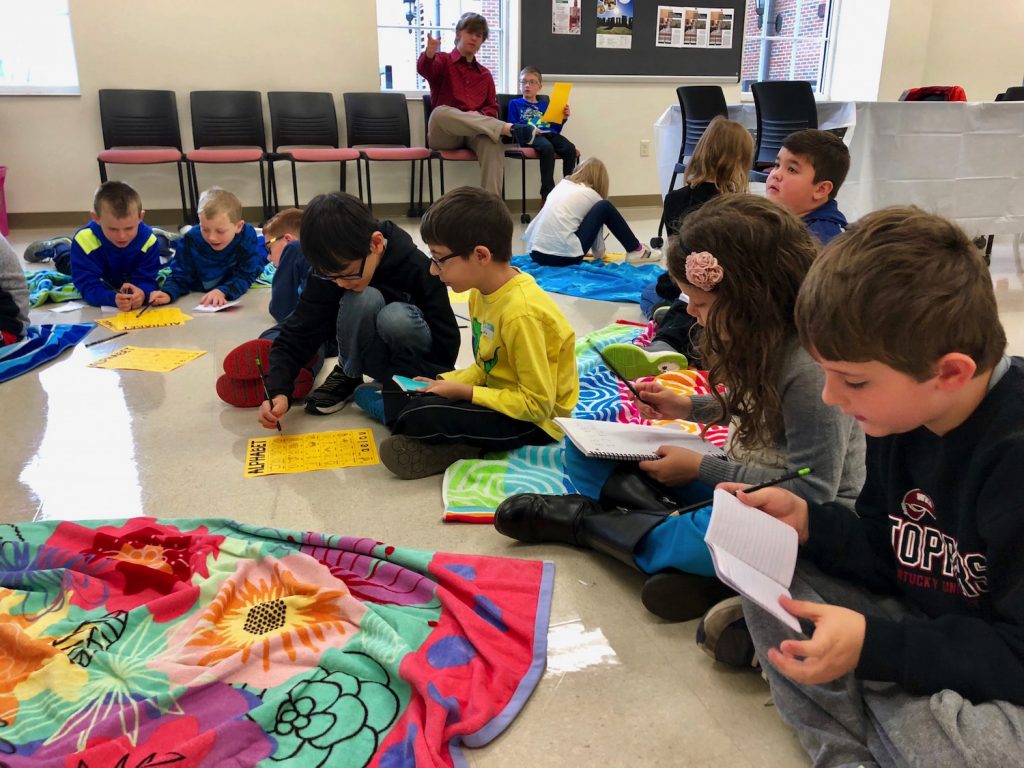By Kate Wintuska
Week 1 Summary:
Our world is surrounded and built by codes. From giving computers directions (binary code) to communicating with others (Braille) to protecting secrets of the past (enigma machine), codes and ciphers matter. In Week 1 we explored why people use codes, the use of a null in a code, and the difference between a code and a cipher.
In the coming weeks we will ask ourselves dozens of questions. From the practical (What does this code say?) to more global questions (How can patterns in language help us solve codes? Is there such a thing as an unbreakable code?).
During our four weeks together, we are using Jigsaw Jones as a mentor. As 2nd grade Private Eye, Jigsaw encounters a new and intriguing code in each of his adventures (ie books). Throughout the book, we see Jigsaw encounter struggle, be frustrated, unsuccessfully try to solve the riddle, and ultimately, preserve. In our class we will find ourselves in the same position.
Solving codes and decoding ciphers is tough work. We won’t always get an instant answer and sometimes we will want to quit. As we tried our hands at backwards and shift code in Week 1, we talked about the idea that challenge can be frustrating but is good for us. Challenge and productive struggle foster engagement, growth, collaboration, and learning.
 These outcomes aren’t a prize of successfully getting the answer rather from the process of thinking and working through ________. In our class, we will praise the process, not the answer asking ourselves –
These outcomes aren’t a prize of successfully getting the answer rather from the process of thinking and working through ________. In our class, we will praise the process, not the answer asking ourselves –
-What did we try that didn’t work? What did that teach us?
-What patterns do you notice?
-What does this code/cipher remind you of?
Week 2 Summary:
Week 1 in Codes & Ciphers was invested in learning a few common codes, ways nulls are used, and the purpose of codes in our world. Week 2 centered around ciphers, codes that require a key to solve.
 Our first code of each session greets us on the whiteboard as the Morning Message. Students are given no hints or help with our initial code. Code-breaking is hard work and offering too many scaffolds or hints stops good thinking from happening. Like last week, our time together was laced with excitement, frustration, failure, big eyes, scrawling pencils, and lots of questions. This is the learning process, and it is exciting!
Our first code of each session greets us on the whiteboard as the Morning Message. Students are given no hints or help with our initial code. Code-breaking is hard work and offering too many scaffolds or hints stops good thinking from happening. Like last week, our time together was laced with excitement, frustration, failure, big eyes, scrawling pencils, and lots of questions. This is the learning process, and it is exciting!
Throughout the code-breaking process, we begin to ask questions about the cipher, with others. Some questions we have discovered answers to, some questions still remain unanswered.
- What do we notice?
- Do we recognize how many words are in the message?
- Is punctuation evident?
- What patterns do we notice?
- Are there letters/numbers that occur repeatedly?
- Is there something that doesn’t seem to “fit” (i.e. a null)?
- Does the code/cipher remind us of any code/cipher we already know?
- What tools might we need to solve the message?
Within our exploration of alphabet, grid, and Caesar ciphers this week, we began to notice patterns and similarities between words within our cipher. Even without the keys for these ciphers, we were able to infer certain words and letters. (i.e. If we know e is one of the most commonly used letters, once I find e I can find the. Knowing the opens the door to t, h, e. Once I am able to relate 3 letters to a code, I can start to infer the key to decipher to code!)
As we head into Week 3, we will be looking at how different codes can be layered to decrease the likelihood they are solved. As a part of this discussion we will look at ways codes are used in the “real world” and differentiate between situations in which we want codes to be easily solved and other times we may want to create more difficult ciphers.

